Ancient Boats of the Sami in Fennoscandia
A BRIEF SURVEY WITH A FOCUS ON THE INLAND ENVIRONMENTS, IN PARTICULAR THOSE OF THE FOREST SAMI
What is a Sami boat? Built and used, bought and used by a Sami language-speaking person? Any effort to discern ethnicity or identity in material culture is fraught with serious problems. But do we have a really good reason for giving it up entirely?
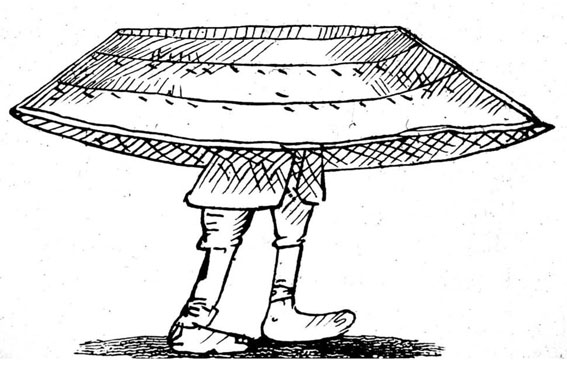 The interest of the Sami peoples for boats and transport by boat in the sea and in inland waters has often been underestimated. But in Lapponia, the famous work of Johannes Schefferus (Jean Scheffer) from 1673 it is emphasized that next to hunting is boatbuilding the most important “art” that is exercised by Sami males. Boats and boat handling has anyway to be studied “holistically” as one of several essential and interacting elements in Sami communities. As to myself I have treated parts of the South Sami area in this perspective. The industries of the Sami appear to be much more varied and manifold than what is normally known, even in ancient times. The specialized and intensive Sami reindeer herding is a stage introduced comparatively late in some Sami groups. There is every reason to demonstrate the potential for boatbuilding offered by the Sami area of Northern Fennoscandia and adjacent regions with similar natural conditions. Solutions to the problems of transport in this largely roadless terrain are of general cultural interest, including not only the construction of the boats themselves but also their extensive use in portages. Such procedures clearly set limits for size. A typical Sami inland boat for river transport was illustrated by a well-known drawing with exceptionally relevant details by Linnæus in 1732 (figs 1-2 ).
The interest of the Sami peoples for boats and transport by boat in the sea and in inland waters has often been underestimated. But in Lapponia, the famous work of Johannes Schefferus (Jean Scheffer) from 1673 it is emphasized that next to hunting is boatbuilding the most important “art” that is exercised by Sami males. Boats and boat handling has anyway to be studied “holistically” as one of several essential and interacting elements in Sami communities. As to myself I have treated parts of the South Sami area in this perspective. The industries of the Sami appear to be much more varied and manifold than what is normally known, even in ancient times. The specialized and intensive Sami reindeer herding is a stage introduced comparatively late in some Sami groups. There is every reason to demonstrate the potential for boatbuilding offered by the Sami area of Northern Fennoscandia and adjacent regions with similar natural conditions. Solutions to the problems of transport in this largely roadless terrain are of general cultural interest, including not only the construction of the boats themselves but also their extensive use in portages. Such procedures clearly set limits for size. A typical Sami inland boat for river transport was illustrated by a well-known drawing with exceptionally relevant details by Linnæus in 1732 (figs 1-2 ).
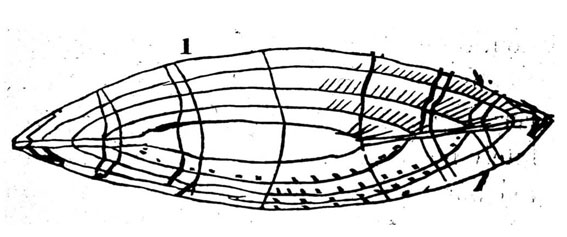 Most sources on Sami boats- historical as well as archaeological- appear when reindeer herding has been accepted as the single most important economy. Ancient Sami reindeer herding culture displays an impressive adaptation to nature and the requirements of work, settlement and transport. It is the most ecologically adapted among the cultures of historical times in Fennoscandia. It has left few traces of its effects on nature and topography, all exceedingly discrete. The constant transhumance movements during an annual cycle meant that definite demands were established on lightness and functional design of everyday objects. This is obvious also in that part of material culture which is treated here. Sami boat culture along the Norrland rivers of Sweden are characterized aptly by Arvid Ehrenmalm in 1743 som “et sätt som liknar them uti theras öfriga lefnadsart”, a way that resembles them in their other ways of life, which is the title of my principal work on this subject.
Most sources on Sami boats- historical as well as archaeological- appear when reindeer herding has been accepted as the single most important economy. Ancient Sami reindeer herding culture displays an impressive adaptation to nature and the requirements of work, settlement and transport. It is the most ecologically adapted among the cultures of historical times in Fennoscandia. It has left few traces of its effects on nature and topography, all exceedingly discrete. The constant transhumance movements during an annual cycle meant that definite demands were established on lightness and functional design of everyday objects. This is obvious also in that part of material culture which is treated here. Sami boat culture along the Norrland rivers of Sweden are characterized aptly by Arvid Ehrenmalm in 1743 som “et sätt som liknar them uti theras öfriga lefnadsart”, a way that resembles them in their other ways of life, which is the title of my principal work on this subject.
It is difficult even today simplistically to connect boat building traditions to what we perceive as ethnical groups. However, there are obvious technical traits which makes it easier to assume Sami origin and Sami life behind precisely boat finds.
Sewing technique.
Later historical and largely contemporary sources testify that the boats used by the Sami are sewn together. By this term is understood that the planks are fastened to each other with stitches of wooden fibres in the very overlap in clinker fashion (lapstrake). Normally this would go as well for the keel and the bottom plank. On the other hand, this does not have to mean that other fastening points, such as the connections between the planks and the ribs (frames) are sewn or lashed together. Of course, lashing in this part is standard procedure in Iron Age and early medieval boats in the whole of Fennoscandia. In some early boats that appear to conform to Sami tradition lashing has in fact been replaced by treenails (trunnels) piercing planks and ribs. It may also be questionable whether the hood ends of the planking always were sewn to the stems. This last comment would perhaps only be applicable in larger boats of greater timber scantlings. If the wood in the current section was thin and potentially brittle sewing would be preferred, in fact even in some small iron-nailed boats, such as that found as late as in the 1930's.
In some cases is also retold how the Sami made their boats in this technique and how they used them. Thus so far it is reasonable that Sami boats have been characterized by their sewing techniques. During the 12th century, the year given is the winter of AD 1138, two large boats were built by Samis (“Finns”) for Sigurd Slembadiækn, a Norwegian king, according to the Heimskringla by Snorri Sturluson. Their peculiar technique and their excellent rowing speed were good reasons for poets to compose scaldic verse in their honour.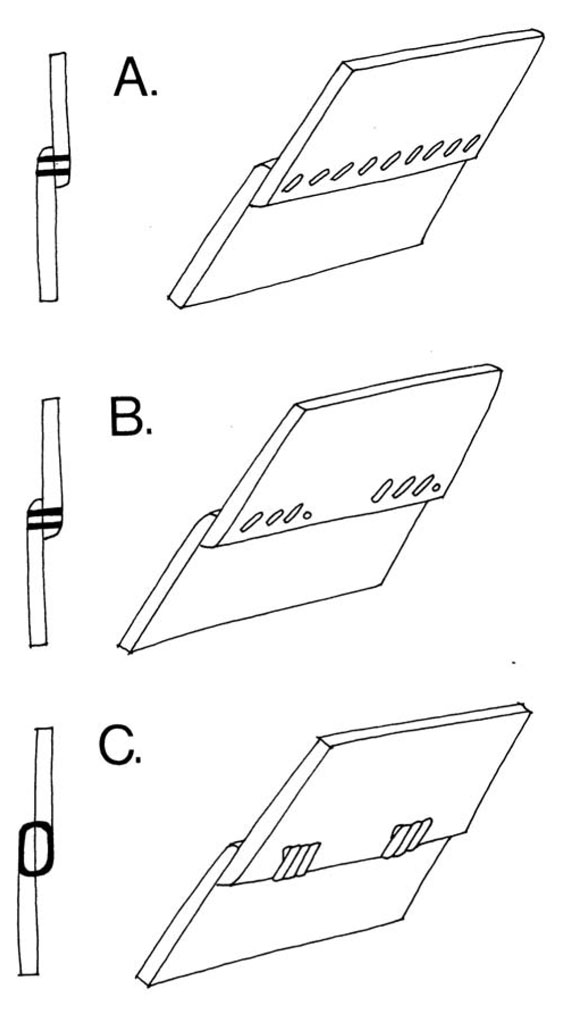
From the 16th century onward the technical peculiarity of sewing is pointed out as most remarkable in a Nordic context. This technique now appears to have been left behind in boat-building among other groups of maritime people. There are many later testimonies. Statements exist from the last century of survival of this trait. In 1939 Ossian Olofsson, a Swedish expert on inland fishing, reports on a boat that he had found that was sewn in its stem and stern but otherwise iron-nailed, in Jiltjer (Jiltjaur), Sorsele, Västerbottens län, Sweden.
But Samis were not alone in using the type of fastening technique in historical times. What we would today describe as ethnic Finns, Carelians, Russians and Estonians appear to do this as well, and in fact fairly recently. However, it seems that it is possible, at least in Finland, to discern three different sewing techniques and that it may even be possible to connect them to some of these groups (here fig 3). The Sami type of sewing appears to be that of the continuously running seam. For various reasons it may be possible, though, that certain Sami groups may have used boats made in other techniques, perhaps all the time, including those of some majority groups of the South. Thus, it could not be stated with any security that sewn boats is an ethnic element uniting all Samis. Where ethnic Samis have built boats for other groups they may have followed the wishes of their customers, which may not have included sewing between the planks. In North Norway the sewing of at least some Samis in boats ordered by others is still mentioned up to about 1700. The Dutch anthropologist A. J. Prins has pointed out that subarctic sewing techniques in wood is not an unprogressive element. Indeed it seems to be changing even in its later times. They were, according to my wording, a functional, but also adaptive, survivals.
Thus it can be surmised in all probability that finds of sewn boats made within the Sami settlement area in historical times are of Sami origin and that Samis have used them. It is obvious, however, that similar fastening techniques in boats were used by all Scandinavians at least before the middle Iron Age. The first finds in iron-nailed clinker (lapstrake) are dated to the fourth century AD. The large Nydam galley-like ship (23 ms) is dendro-dated to c. AD 310. The youngest boats in sewing technique in South Norway have been dated by radiocarbon to about the same period, the finds of Valderøy to AD 245 (calibrated to a wider span AD 240-420) and Halsnøy to AD 335 (ditto AD 390-535). Moreover, the latter is the first Scandinavian rowing boat although there are earlier finds, possibly from the first centuries AD, of single rowlocks. Before this period all boats appear to have been paddled. Sewing or lashing techniques may with some confidence be regarded as a genetically early element in wooden planked boats in a more or less global perspective of culture.
Consequently it may be more doubtful to apply the geographical criterion for Sami boats earlier than the 16th century in South Scandinavia. Of course, boats are by nature singularly mobile artefacts, and a possibility remains that early coastal Samis, or their customers, could have left their boats to rot even here, especially along the long Norwegian coastlines.
Thus, by sewing is in this context meant planking connected to each other by was of root fibre cords, mostly of spruce or pine produced in a particular spinning craft in the forested countryside, or by twisted reindeer sinews, in the last stage by hemp ropes or cords, possibly cobbler's thread (with pitch). It has been suggested that in order to give a more unambiguous illustration of how the boats were made the technique used would rather be called lashing than sewing. By sewing is normally meant a technique where the hole in the material is made at the same time that the thread is driven through by way of a needle. In lashing you would bore a hole in advance. This is undoubtedly how the Sami (and other) sewn boats were fastened. At the same time it would be possible to avoid an unfortunate thought association. Another type of sewn boats are skin or hide boats, perhaps better known as sewn in popular imagination than the wooden boats. Skin boats are indeed sewn in the normal way. By way of an identical terminology for both boat “types” it might be inferred automatically that sewing in wooden boats quite self-evidently has its origin in the sewing in leather or hides. This is highly doubtful. There is an apparently original and quite specific technique of sewing in wood, of which some varieties can still be studied in small containers in the North. The varieties used have parallels, although some rather distant, in larger artefacts, especially boats. Apart from this, the sewn skin boats are constructed in quite another fashion than wooden planked boats. Skin boats are built with their entire wooden skeleton (laths) first and moreover, they are built upside-down. The original method for making any kind of wooden boat is to build the planking up from the keel right side up. Only after this procedure is finished (at least partly, in the bottom) is inserted into this shell the skeleton, the frames and other athwartships pieces. This would be referred to as respectively the skeleton-first (frame-first) and the shell-first (hull-first) methods.
However, there are other, terminological aspects of great importance. Firstly, the term “sewing” for wooden boats has now been accepted more or less universally. But more significantly in a regional perspective, a number of ancient terms of planks and their contact surfaces in several languages, including the Nordic, such as the Nord. sud, clearly indicate that the verb 'to sew', Nordic syja, has been used for the boats. This includes Latin and Greek terms as well. Thus the primacy goes to the verb “sew” and the noun “sewing.” But in this text it might be possible to use the terms sewing and lashing as synonyms, only due to the need for variation, although the context may be important. But the tree fibre fastenings between planking and ribs will be referred to as “lashings,” and in this case consistently.
Many terms of boats in Sami are of Nordic (North-Germanic) origin. This has often been interpreted as if Sami also had taken over their boat technique and its terminology from the Norse. This conclusion may be doubtful or at least only a partial explanation. Contacts and interaction may have been established in many ways. As we have seen, Samis in North Norway are known to have built boats for the Norse at least since the 12th century and most probably much earlier. This had partly a topographical cause. Most Iron Age fishermen-farmers entering the area from the south settled in the treeless archipelagoes at the outer rim of the lands. The Samis appear to have been already settled in the inner parts of the fiords where the forests were dense. The Sea Samis or their Proto-Sami precursors (whatever we would call them) can be considered the earliest known established expertise of both the area and its distinctive features. Thereby they had acquired both maritime experience and knowledge of boat building adapted to the area. The Nordic terminology in Sami languages and dialects could be dated to this period and also to this area. It may perhaps be explained partly as an adaptation to those kinds of boats which were ordered by the Norse. But this is problematic. A process of acculturation never goes just one way. It consists of several stages. Terminologies on boats, indigenuous Sami and external, were most probably parallel from the beginning. But why where only the imports made permanent? In his review of my book [from 1987] Björn Varenius (1989) gives some possible explanations: the social status of the Sami may have been diminished even in their own eyes concomitant to them becoming a minority in their own lands and their own terminology may therefore have been purged. Moreover, their own boats were too small to acquire status by themselves, and the sewing techniques may have been considered outdated, unsecure and brittle. Some of these arguments are mentioned by Norse and other travellers among the Sami, but only in later times, in marked contrast to the reaction quoted on those elegant galleys allegedly built in AD 1138. But the North Germanic loan words in Sami do indeed occur in many other fields, especially in agrarian matters, where the Southerners certainly were the givers.
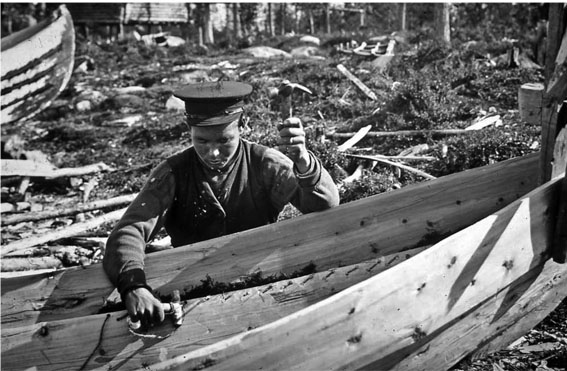
In other places and times where sewing of wooden boats seem to be an original technique, like Bronze Age and Iron Age of Western and Southern Europe, the thread was led mostly through one plank at a time, then across a rounded edge and then through the second plank. In the Sami area most of the sewing appears to have been made through both planks at once. This might have occurred as an emulation of nailing, either by wooden pegs or iron nails. In this connection the single Finnish nide (Swed. näst) stitch could be considered the only one which cannot be suspected of being of Norse origin.
Anyway, to some extent these differences could perhaps be explained by a variation between clinker, lapstrake, method or in carvel fashion, edge-to-edge or intermediate stages between them. But this is pure guesswork. The comment above has an unfortunate strain of genetic diffusionism without taking account of difficult questions on e.g. acculturation and interaction. Even if the observation is superficially correct it should arouse scepticism.
Moreover, it is possible to discuss whether treenails as fastenings between planks is a direct descendant of the sewing technique or a separate side-line. Treenails have, even in later times been used in sewn boats to close, lock or seal the stitsches, in particular in a running seam as the typical Sami variety. On the photo of Gustaf Hallströms from Nuotjaur on the Kola peninsula in 1909 the Sami boatbuilder is shown tightening the seam at a stitch by way of a T-formed (hammer-like) implement of wood and at once hammering in a treenail (see figs 4-5).
This is also a doubtful idea. It is only in some rather well-defined times and areas where we can state that treenailing is the dominant trend in the history of boat-building. The only examples of the North is the West Slavonic area during the Viking Age and the High Middle Ages (European style). Otherwise the fully blown treenailing tradition is known from Åland in the Baltic and on both sides of the Skagerrak (including lake Vänern) but only in historical times. Certainly, boats fastened by treenails may have been used up north but they must in this case be so distant in time that no genuine tradition about them would reasonably have survived.
Prehistoric boatbuilding equipment?
Above has been mentioned the T-formed tightening device in Hallström's photo. This tightening device has god counterparts in the sewing of boats, in particular in the Pacific. It is an integral part of sewn boatbuilding in wood. T-formed Neolithic red slate implements (fig 4), of clearly combined functions to a certain extent, are mostly found in coastal seal-hunting settlements in Ångermanland in North Sweden of c. 3000 BC, but spread inland as well, have been compared by me to this recent mallet (or hammer-)-like tightening device of wood for sewn planked boats in the same area (fig 5). This later implement was used in boat building by Sami boatbuilders who are among the latest users of such boats in Europe. This comparison appears problematic, not least owing to the awesome time gap of 4000 years. But a tightening device is, as mentioned, imperative in lashing or sewing in wood. A possible example could have been an implement found at the North Ferriby site with its four boat fragments of c.1400 BC at the Humber estuary in England.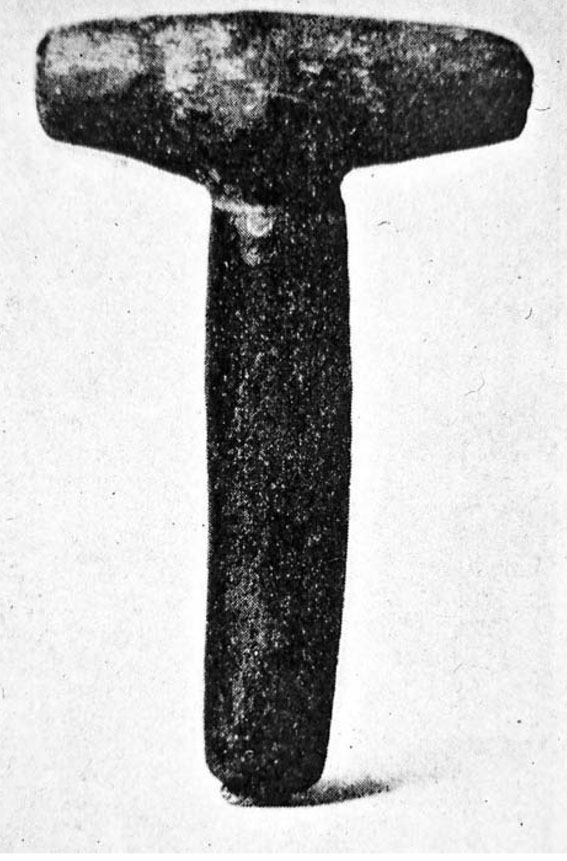
The problem of the time-lag is still apparent in the following. But the T-form of the Neolithic slate implements seductively connects them also with recent shaman drum accessories of antler. Interestingly, the material properties of slate have been deemed almost identical to those of antler (and to some extent bone) by Nordic archaeologists.
There are two drum implements with different functions. The “hammer,” a reindeer antler fork of the drum was used for the séance of the shaman (noaite, Swed. nåjd) and the smaller, slightly different “pointer” served divinatory purposes by its ultimate position on the drum skin. The shaman's drum (Saam. /south/ gievre or /north/ guobde) was metaphorically identified as one of his technical “helpers” or “vehicles.” In fact it was explicitly his boat, during journeys between the world elements -water, air, earth- in his ecstatically engineered soul absence. Among the Evenks of Siberia (the shaman was) “floating down the shamanistic river into the lower world- the khergu. His drum served him in this case as a boat, and his shaman 's drumstick as a paddle” (my italics in the last sentence). And a further argument: “Calling a drum a boat is also more than an expression of figurative language. Mythical images or metaphoric expressions are often understood as a real manifestation of the signified. The drum-boat, for example, can be visualised and sensed as a real object in visions and shaman songs.”
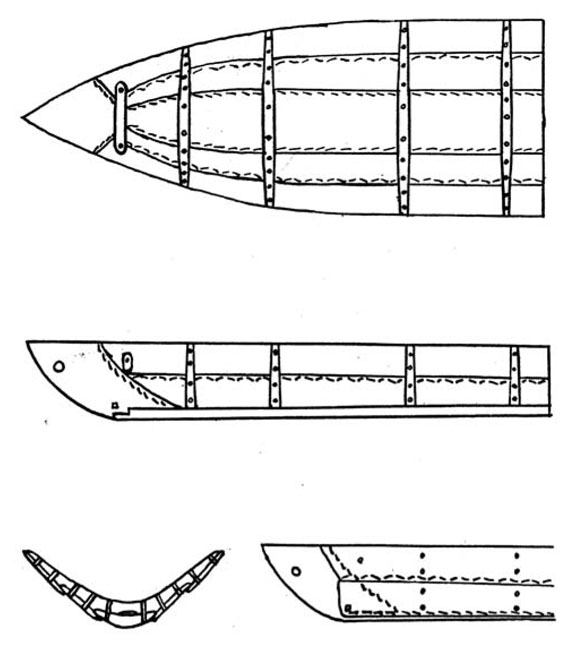 The time-lag between these items may be cut down considerably, perhaps to 2000 years, but still an overawing distance, due to rich finds, including such implements, in a Proto-Sami settlement in Kjelmøy, in the Varanger area of northernmost Norway from c. 800 BC and onward. It has also been found in a grave a little further south, apparently female, from the first centuries AD. The same Sami term for the drum hammer, translated as “reindeer antler hammer,” is in fact used in recent times for the mallet-like implement for tightening lashings, although it is made of wood. There is for this reason a cognitive connection between the tightening of boats and forms for ecstatic divination. It could have meant a parallel transformation and transmission of all three forms as metaphors and symbols. This also has bearing on the materials used.
The time-lag between these items may be cut down considerably, perhaps to 2000 years, but still an overawing distance, due to rich finds, including such implements, in a Proto-Sami settlement in Kjelmøy, in the Varanger area of northernmost Norway from c. 800 BC and onward. It has also been found in a grave a little further south, apparently female, from the first centuries AD. The same Sami term for the drum hammer, translated as “reindeer antler hammer,” is in fact used in recent times for the mallet-like implement for tightening lashings, although it is made of wood. There is for this reason a cognitive connection between the tightening of boats and forms for ecstatic divination. It could have meant a parallel transformation and transmission of all three forms as metaphors and symbols. This also has bearing on the materials used.
The shaman is not a master because he is a boatbuilder but precisely because he is a shaman. But a possible status of a boat-builder as well as a shaman as a metaphorical “bridge-builder” (the term of the Roman priest, Lat. pontifex means “bridge-builder”) across waters (and other elements) could have affected society as a whole. But the boat-builder's status is certainly variable in different societies and contexts. To some extent particular social groups, maritime or not, may have been specialized as boat-builders and their status may so, accordingly, depend entirely on their group status. Samis were indeed boat-builders for the Norse in historical times, but generally speaking, their status among the recent Norse appears to have been low. But there may have been quite another story in the past. This is definitely the case in AD 1138. It does appear so also in the fairly high status boat grave in Norse tradition of an apparently Sami elderly male in Lekanger, North Norway.
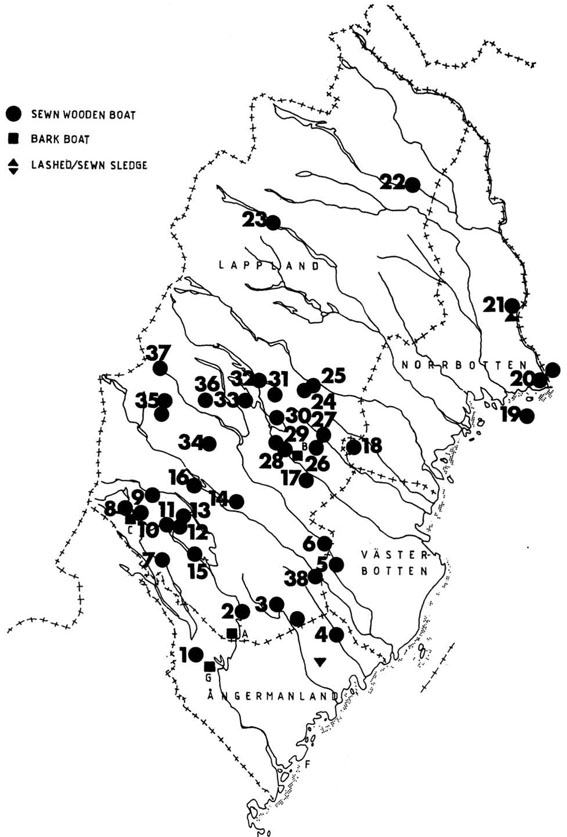
Starting in a modern research tradition where ethnicity is a highly situational process this hypothesis on a tiny implement would be less interesting to a discussion on Proto-Sami identity than just to boatbuilding tradition. But personally I would rather want point to la longue durée in shamanistic tradition and mythology all over the Arctic and Subarctic area.
The finds of sewn boats.
Before giving a survey of the finds of sewn boats just a few words on other boats. Other vessels within the Sami area include floats, bårre, pårre, of different types. Kristoffer Sjulsson calls them bloata, which is a loan-word from Nordic languages. Finds of logboats appear to be connected to Nordic and Finnish contexts. From the later parts of the 16th century such finds seem to be highly characteristic of Finnish forest colonizers in south Norway and Central Sweden. They do not belong to the Sami areas in the north. On the other hand they may have been made and used by smaller Sami groups in the south.
Finds of sewn boats in the present Sami area are fairly numerous. However, most of them are fragmentary and some are in fact uncertain, since they have never been documented. By this is meant that the oral records on such finds are many but very few if any at all have been the object of a thorough excavation with scientific ambitions. Not even the best preserved occur in coherent shape. There are in fact only two such cases, from Storholmen at Skellefteälven river in Lappland and Valkijärvi in Vittangi, Norrbotten, both of them in Northern Sweden. None is dated. There is also a fairly complete sewn pulka or ackja (Swed., from Finn. pulkka, ahkio, Sam. kieres, gieretse), a Lapland sleigh, dated to the 13th century, which seems to be basically a boat turned sleigh or anyway with its prototype in a sewn boat, from Soukolojärvi in the river valley of Tornedalen, found in the vicinity of a boat stem (here fig 6.).
It would sometimes appear as if some parts of boats or blanks for such have been submerged intentionally to be used later. This is reasonable since many of the boats have been extraordinarily brittle, to judge by sources in literature. Most have been ordinary, everyday, vessels. Finds of single ribs and bulkheads remind us of the statement by Högström 1746 that the dog took the bulkheads in his mouth at a portage while his Sami master turned the boat upside-down and carried it on his head, steering the vessel through the dense Salix osiers with his oar.
At least about 60 sewn boats and fragments of boats have been found according to statements registered by me. In four cases in Sweden they are preserved and/or documented to some extent, perhaps there are about 10 in Finland, some of them documented, at least 11 in Norway, of which 7-8 are preserved and/ or documented, including one intact little boat from Pasvik at Kirkenes almost at the border to Russia (University Museum of Tromsø). At least a dozen of these are dated by radiocarbon (map mostly of inland finds fig. 7).
A Sami origin for the Viking Age boat find from Bår(d)set in North Norway is problematic. There are a few traits which point in this direction, but the general character of this vessel is Nordic, according to several other authors. But I still believe that this boat was built by a Sami boatbuilder for a Norse customer.
Three oral statements exist on boats made of birch bark, of which two are quite detailed. These finds appear to be unique in Europe. But none of them is documented or dated.
The wooden species, the material for sewing and the caulking (luting) material has probably been variable but very little has been scientifically analyzed.
The finds of boats and parts of boats correspond well with the historical sources. Moreover, both source types give a good overlap in time. Dated boat finds seem to confirm the main forms of Sami boat culture from the 7th and 8th centuries AD up to the 19th century. Other statements in various kinds of literature cover the period from the end of the 1130's up to the beginning of the 20th century. Different environments and economies of the Sami are reflected in several boat types and sizes with somewhat changing details of construction. But there are common traits as well, such as the sewing technique. Others are the form of the ribs. There is a clear tendency at least in the stem and stern for high and fairly thin framing, thereby similar to bulkheads (see fig. 2). These ribs are lashed to the planking, while ribs in other boats, lying closer together than in Nordic vessels, are treenailed quite early. These tendencies can be observed already in the Viking Age. But the material is very scarce.
The reasons for the survival of sewing in the Saami area are apparently many. Partly they may presuppose the use in this context of ethnic signals, a kind of neighbour opposition (a term borrowed from linguistics) which, however, hardly could be isolated from the function and use of the boats in their specific Sami context. In referring to parallels it might be fruitful to remember resistance against innovation from above in comparable situations, e.g. the survival of sewing in larger North Russian vessels among the Pomors until the 19th century in spite of early ukases from Czar Peter the Great in the first part of the 18th century. European standards were encouraged by economic means. But even threats of heavy punishment helped very little.
Other factors are fairly plain. The inland Samis needed light boats which ought to be repaired at the spot with material easily available in nature. It must be pointed out, though, that the production of twisted root fibre cords of high quality requires a lot of preparation. Was there a dearth of iron inland? We know from a few historical sources that some of the Norse in Greenland during the High Middle Ages had to sew and lash their boats together. The lack of wood and tar led to the partial use of train oil, mostly from seals, to impregnate boats. This is also known from the coasts of the North Samis. Another possible advantage with sewing technique is that the fastenings of the boats can relatively easily be dissolved. We also know about the rhos, mainly Norse people, from the account of the Byzantine emperor Constantine VII Porfyrogenetus in his De administrando imperio (Pros ton hyion Romaion) that some stages in boat transport across Russia and along its rapids meant partial dissolution of boats and concomitant portage over land. There are ethnographic parallels among the iban people in travelling by boat across the watersheds of Borneo/ Kalimantan.
So far, sewn boat finds do not occur south of northwest Ångermanland in Sweden. This lack of finds has been interpreted as one of the northerly cultural elements which does not transgress a cultural border zone in this province. The ropes of treeroots for the sewing is another of these elements, like the production of them among the coastal Sami groups in northern Sweden. However the dearth of finds in Jämtland or further south may also be interpreted in other ways. Either did Sami groups not use sewn boats here or they did not settle here until later times. The later possibility is not discussed here, and there is little else to such an explanation, especially since the presence of reindeer hunters and maybe also small-scale reindeer herders seem to be recorded by archaeological finds at least during the Viking Age (AD 800-1050). Still, the lack is striking.
The boat has left significant traces in Saami cognition and representations. It is an important symbol. The supernatural loading found in connection with boats, boat buildings and shamans can only be indicated here (cf above). An obvious sign is the comparative wealth of boat figures on shaman drums. Fairly recently sailing ships together with human figures have also been found as rock carvings, probably Viking period, in Baddjelánnda (Padjelanta), Norrbotten. The connection between the Lapland sleigh and the sewn boats should also be noted. Boat graves are common among the Norse in pagan Scandinavia, and in Sami lands the burial in Lapland sleighs is fairly common. These phenomena are widely separated in time but may express similar metaphors. Boat graves normally represent high or middle status. An interesting boat grave in Salten, Nordland, Norway probably contained a prominent Sami male, and why not a boat-builder? This kind of burial could perhaps deliver arguments in a discussion on shifting identities, religion or ideas on the status of contemporary boat-builders both in Norse and Sami society.
The attitude to sewn boats in the majority societies.
This attitude has certainly varied over time. As far as the tradition of sewing wooden boats was common even in the south (the first four centuries AD) no Sami-built sewn vessels would have been remarkable. Of course other traits could have expressed a local identity but no information exists. The span of attitudes is wide even later. As mentioned already there is a great difference between the praise of the scaldic verse in the Heimskringla ot the two 24-seater galleys built by Samis close to Harstad before the middle of the 12th century and later attitudes to Sami-built boats, although these later are only much smaller vessels. But in 1732 the appreciation -and evidently also surprise- is obvious when Ehrenmalm in 1732 comments on the Sami skills in handling their boats in the rapids of Ångermanälven. On the other hand we also know the scornful words on a Lappish “näverrifva,” a kind of simple birch bark cup, that allegedly were used for Sami-built boats by the dean of Vilhelmina, Olof Ersson Lindahl in the later half of the 19th century. Lindahl was used to be rowed along the extensive lakes up and downstream in those boats to his sermons in the mountain chapel of Fatmomakk. But most of the travellers from the outside were understandably afraid while confronted with techniques possessing unknown qualities, in particular if they were to sustain themselves and their possessions. From this situation a lot of folklore, including migrant tales, can be deduced. Sewn boats in poor repair with their brittle planking were supposed to sink easily. Bask is a curious term for a vessel type in the Varanger/ Tana area in North Norway. It seems to derive from Finn. paski, which means “shit.” Could this attitude among some southerners, provided that the original boats were sewn, be the background?
The use of boats in Sami communities.
Most of the sources recording use mention fishing. This starts already with Olaus Magnus in the beginning of the 16th century. Högström emphasizes at the middle of the 18th the need of boats among those groups which were called fiskarlappar, fishing Lapps. The many finds made of boats in the vicinity of small lakes and tarns substantiate these statements. All Samis depended to a great extent on fishing, at least seasonally. The coastal Samis at the North Atlantic were active not only as efficient fishermen but also as skilful hunters of sea mammals. It is most probable that Sami-built boats have been used as well in fishing and other coastal culture in the northern Baltic. This may be indicated by a few finds in the innermost Bothnian Bay.
During the time when there was no snow on the ground (Swed. barmark) the boat was the most important means of transport everywhere in the inland area. The distances which had to be covered were often staggering. Certain authors, like Ehrenmalm 1743 points out that boats were used by Forest Samis in the movement between different settlement sites in the tax land (skatteland, Norw. bygselland) during the annual cycle. Lundius points to the transport to the churches during important holidays, which often for practical reasons were combined with markets. Probably already Ziegler was alluding to similar markets in the 16th century. The use of boats had also a more official aspect, which was quite common in these days. The only means available for the transport of travellers and government officials from the outside were quite simply the Sami-built boats. The Sami had to be the rowers and ferrymen and were paid for it. Most of our best written sources appeared in connection with such journeys. The authors were very probably the only literate persons moving around in the immense inlands of Lappland. Some important names are Rudbeck the Younger (d.y.), Meldercreutz, Linnæus, Högström, Ehrenmalm, Schnitler (Norman), Tilas.
Of course there were more specialized fields for boats. At several tarns reindeer and other hides were left to soak. Sometimes boats were built only for this purpose, This was explicitly mentioned in the traditions on a boat find at Hangajaure, Sorsele, Lappland. On the other hand the advanced technique of that boat may mean that it had been built for a less mundane function.
The distribution of the finds made in present Sweden shows a remarkable concentration to the Forest Sami culture. In several cases finds could be directly connected to Forest Sami camp sites, and if not, it seems highly probable that they indicate as yet unknown sites. The Forest Sami culture, with its manifold economic niches, has always been more dependent on fishing in the träsk (lakes) than anything else. Their reindeers were kept in small herds close to the camps and were regularly milked. They may have had other domestic animals as well, especially goats. Otherwise hunting took over during the long winter (fur animals, elks, bears).
In this roadless country boats had to be carried to fishing and transport, even if many principal camps and lakes especially important for fishing had been provided with boats built only for this permanent locality. During the transports along the river valleys it would anyway be necessary to carry or haul boats at the rapids and between the watersheds on portages, the mårka (Saam. muorka, Finn. muotka, matka). Graan mentions at the end of the 17th century the carrying of boats for many “mil” (10 kms). The modes of transportation to which the light Sami boats were adapted, this rapids-shooter way, the carrying, dragging and hauling across portages and watersheds is an original characteristic of mobile life in the entire Scandinavian area, in particular in the immense inland areas of Sweden and Finland. Similar modes are as common in the circumpolar subarctic taiga. But the complicated networks have never been systematically mapped. A single unique survey of documented portages has only been made for parts of North Norway, most of them used up to our own times by Samis.
The first mention of this particular mode of transport is found in the classical description of the Northerner Ohthere (Ottar) of the boats of the cwenas (the Anglo-Saxon form; a counterpart to modern Swed. and Norw. kväner, Finn. kainulaiset). Their small, very light, boats were carried between the extensive lakes of the interior and evidently even across the mountains. This account is dated c. AD 890. The Swedish place name specialist Bengt Hesselman has also recorded the prehistoric carrying sites/ portages in South Sweden. A number of similar place name types are known from Finnish and Sami territories. As could be expected, the entire European part of Russia contains place names with similar meaning, esp. volok, portage, watershed. Even though the topographic background is somewhat different than Fennoscandia, by way of extensive plains and majestic rivers this immense transport zone across Northern Europe has been called by me Zavoloshe, Lat. trans iugum, 'on the other side of the (Great) Volok.' This term originally denotes a large tax area of Novgorod during the Middle Ages from the watershed and the sources of rivers running towards the Arctic Ocean down to that sea. Olaus Magnus mentions the same ways of boat handling by Russians (or Carelians) in the inner parts of Finland to be able to arrive at the market in Torneå in AD 1519. Larger, but still light boats, for 20-25 rowers are told by the same author to give strategic advantages in Sweden because they can be carried overland. My own interest for this mode of transport and its implications led to an international symposium and a recent publication called The Signficance of Portages.
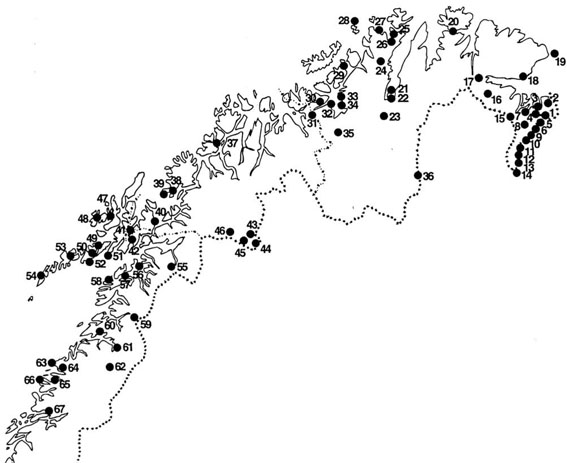
The question of the genetic connection between the boat and the Lapland sleigh is fascinating. Both do belong to fundamentally subarctic transport techniques. Was the sleigh developed as a winter version of the portage of the boat? I still maintain that the North retains its particular value to demonstrate by way of functional survivals and interviews of still living people how the transport modes looked like in the roadless prehistory of lands much further south.
Boat types.
The available descriptions of Sami boats and boat finds outline a picture of two main types. These display particular traits and variations within the same type evidently related to their function and area of use.
The small boat
The first was a very small and very light vessel. It was extremely wide-spread throughout the Sami area. I sketched a model for a certain find of Sami making and use in my book (1987) which is identical to this type: “a (small) vessel sewn with a running seam, light and portable, from historical times, the 17th-19th centuries, found in the known area of Sami settlement during this period.” It could be called a håp in some Swedish northern dialects, a term derived from Finn. haapio, a vessel originally made of haapa, the aspen tree, and normally extended. It should be mentioned, however, that even a larger boat is called håp by Olof Rudbeck the Younger (1695). In South Sami it is called vints. It was in fact so small that Lundius (1671) mentions that it could be blown away by the wind if you did not weigh it down with stones. At the same time it was very brittle. Ehrenmalm (1743) and Tilas (1745) affirm that it had to be handled carefully, in particular when you stepped into it lest it might break into pieces. Linnæus (1732, 1811) informs us on edges of planks which were only 0,5 mm thick. This can be substantiated by a few finds. Other parts of the planks were at least of the double thickness. The planks were anyway fairly wide, at least 22-23 cms. There were 3-4 of them on each side of the boat, according to the author of the rimkrönika ('the rhymed chronicle' c. 1700) and to Ehrenmalm, and these were 5-6 ribs (Linnæus). Ehrenmalm mentions a keel length of 1,8-3,6 ms (3-6 alnar appx. ells, of 60 cm each). The lower size would correspond to 2,4 m (4 alnar or ells) as the length overall. The general measurements are given by Linnæus as length 3,6 ms, width 1,5 ms and depth 0,6 m.
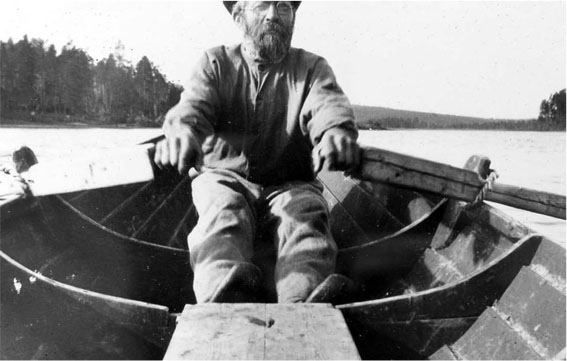
There was no bulwark or rail according to Kristoffer Sjulsson, in his memories before 1850, probably substantiated in the find of Välkijärvi, Norrbotten, Sverige. This find is comparatively complete. Traits also described by Sjulsson recur in later working boats of the lappmark, a seat board in the center, the lack of a supporting crosspiece (Swed. knaft) in the stem and stern, but on the other hand triangular lengthwise boards in these sections to sit on. The support for these triangular boards are the bulkhead-like, high but fairly thin, ribs (fig. 9-10). There is also at least one hole piercing the bottom to empty bilge water, mentioned by Kristoffer Sjulsson and Gustav Köniksson (record of interview). As can be seen almost all of the details derive from the 18th and 19th centuries.
This boat type was designed to carry one person and 8-10 nets. Otherwise there was only room either for another person than the rower or luggage of corresponding size to the nets. The type can be substantiated mainly from historical times in South Lappland. But recorded statements also indicate a remarkable continuity. It appears, with some qualified guesswork, to be a survival within the inland Sami areas and may reflect a number of original Sami traits. It is an astoundingly versatile rowing boat, but it seems always to be adapted to its main use in rivers with rapids. It is also used in small lakes. On the other hand it is for understandable reasons never sailed nor used in the large open waters of extensive lakes.
Somewhat contradictory statements exist on the time needed for its construction, its price etc. These may reflect various local conditions and experience with boats in e.g. the North and the South of Sami territory.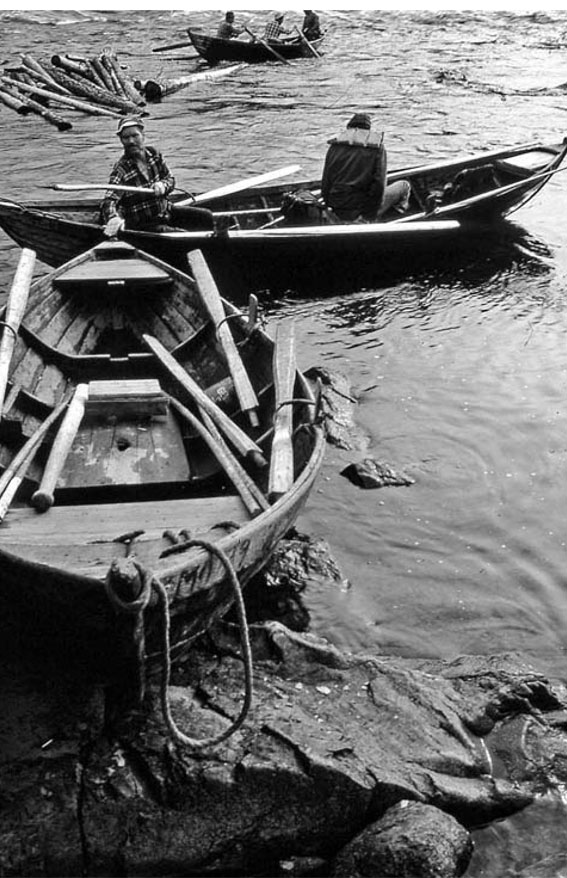
If not a boat was at the spot, as expected, along the river or at the shore of a lake, it should be possible rapidly to make a substitute. There is an extreme statement by von Düben who says that the making of these exceedingly thin, portable boats may only require a few hours. Perhaps von Düben was deceived by a humorous informant? (Samis were known to dupe credulous Southerners) A more reasonable (in our ears) estimate is a few days, and in this case the wood had to be there.The longest time recorded by me is a working week. Divergence of opinion on the time required to make a small boat is displayed in particular by Kristoffer Sjulsson. He is certainly a realist, but he mainly represents an inland area between the great lakes and river valleys. Sjulsson states that it was difficult to make a boat and that the work took several weeks. Perhaps he was thinking of a more advanced vessel made to be permanent and not for a temporary crossing? On the other hand the price for a boat given by Graan partly proves the point; 3 lod of silver or a reindeer (an adult).
These statements may be compared to those made by boatbuilders in Norwegian tradition. They were also remarkably efficient. Christensen & Færöyvik mentions that “in most districts, a four-oared boat was considered to represent a week's work!” This is in fact a considerably larger boat than this small Saami boat type. A reasonable conclusion is simply that there was much of varied quality in everyday wooden handicraft in the Sami inland areas and that the semi-professional work along the Atlantic -also by coastal Sami boatbuilders- was more uniform and regular.
As mentioned there are a few statements on finds of birch bark boats. Unfortunately there is so far no documentation of any find but I have no reason to question their authenticity. These statements conform well with the model and size of the small wooden boat, the håp or vints. The existence of vessels made of birch bark could possibly be indicated by the Christmas offer in a birch bark container in the form of a boat as recorded by Rehn. These condescending words on Sami boats comparing them to a simple birch bark cup (“näverrifva”) by the dean Lindahl (above) are more uncertain as evidence (recorded by Kristoffer Sjulsson). From a general point of view the statements of birch bark boats are of course sensational, “electrifying.” They are unique within Europe. But the French count Loménie de Brienne does in fact in 1654 mention sleighs made of birch bark in his account of the Sami.
The larger boat.
The larger boat type of Sami tradition is more difficult to give a name. It is intended for transports in more frequented routes in large rivers. It seems that it was used also in the extensive lake systems in the mountainous area. At least was it mostly found in the northern lappmark during the time of Högström in the middle of the 18th century. It was 7-9 ms (4-5 famnar, fathoms), according to the same informant. An even greater size is recorded from the Torne river by Olof Rudbeck the Younger. It was according to him a long, narrow vessel of 11 ms length (18-19 alnar, “ells”) but only with a width of at most 1,5 ms (2 ½ alnar, “ells”). It was built only of 2-3 planks on each side. As mentioned, even this boat type was called håp by Rudbeck. Basically this large type could have been intended for lakes, and for sailing, but in this case certainly modifications have been made, in particular concerning its length/ width ratio. Sails of bark, most probably birch bark, are mentioned already by Olaus Magnus for the large inland waters.
Unfortunately there are no finds of this boat type. Its general lines seem to indicate influence from the Finnish river boats to the east. It is to be surmised that it got iron nails fairly early, perhaps already during the later part of the 16th century.
The boat(s) of the sea.
Apart from these main inland types we also find a larger sea boat, intended both for rowing and sailing. It left a mention in the Middle Ages by way of Snorri Sturluson for the years 1139-40. This type may be represented even in some Norwegian finds, such as those sewn planks which found a secondary use in medieval Nidaros (Trondheim). Hypothetically it might correspond to smaller fleet types or galleys at the Atlantic, from perhaps 10-12 up to 25 ms. This larger size is computed from Snorri's statement on 12 rowers on each side. The find of Trondheim could represent this range, but this is only a guess. Another interesting early statement is that of Olaus Magnus, that such, larger sewn vessels, called scutha, a traditional term still alive for a sailing cargo ship (skuta, skude, skute) still were sailing the Bothnian Sea. Their connection with the Sami is not clear in any way. There were, as mentioned, several other traditions in sewing techniques in the area, such as the Russian. No finds exist, except a Russian ship in Stockholm, probably from the 18th century.
We have already mentioned that the small Sami boat type seems also to have been used at the sea in the innermost Bothnian area.
Amphibious depots.
This author has discussed similarities in three northern find depot sites for remains of sewn boats. All three seem to be dated to the 13th century or thereabouts. The model find is Keuruu near Jyväskylä in Finland. The find is extensive and consists of numerous parts of several boats, but also a considerable number of skis and sleighs and blanks for making such. This combination seems to recur to some extent at two other find sites, Soukolojärvi in the Torne river valley and Tjautjer or Gråträsk in Piteå landsförsamling (countryside parish), both in Norrbotten, North Sweden (fig. 11). Graträsk is also the place for a possible Sami sacrificial find. But these find sites are much less marked, in fact rather obscure.
Suojoki in Keuruu is a small river debouching in a wetland, followed downstream by more extensive lake and river systems. Upstream there are no longer any coherent water systems. You are up on the forested plateau where no permanent settlements could be found during the Middle Ages. Even south of Keuruu the population was very scarce. The find site is in the wetland below and adjacent to the river.
My hypothesis is that this would be the remains of a site where a transition was made in late autumn or the beginning of winter between boat traffic and further transport on sleighs and skis. Already in the topography there are several indications, particularly the fact that this marks a transition also in the nature of the water systems. I have tried therefore to imagine a situation where traders or hunters from the outside have left their equipment. For some reason it has never been collected. But it is curious that these wooden artefacts have been preserved. Of course in this lush ecology they may have been overgrown by vegetation during the next season and consequently perhaps not refound. They may also have been submerged and thus invisible. However, it appears that some of the wood from the start were deposited in water. A reasonable conclusion would be that this happened intentionally. At least for the blanks, intended as future transport means, a reference could be made to traditional boat-builders use of wetlands to keep their wooden material in water before shaping them. Such find sites, including stems and ribs, are quite common in Scandinavia and e.g. Scotland. But sleighs and skis are uncommon. There are thus indications of a local or rather regional cultural background, diverging in this respect from the remainder of similar wetland finds of Fennoscandia, except possibly those mentioned, in the very north. The closest counterpart to such a site where transition to winter is prepared during movement was found in the Sami höst- och vinterviste (autumn and spring camp) in the mountains. Not only transport means, but also clothes, fishing nets and food were stored here in huts, booths and stone cists for the winter. The Samis left this camp with their reindeer herds for a 300 km transhumance leg on the snow towards the Baltic coastlands. At their return in the spring this store, presumedly still covered partly with snow and below the freezing point, remained at the disposal of the family group in question. This does not mean that I necessarily connect the current sites with Samis. But the transport mode could be similar in both cases. On the other hand the only people living in the vast inlands of Finland at this time would have been Samis. The same goes for the inland of Northern Sweden. The contemporary conditions of wilderness exploitation in trade could also be brought in as an argument. From Western Finland were recruited fur traders and colonizers to the present Swedish north during the Middle Ages. The two sites of Norrbotten were certainly minor in comparison with Keuruu, but their function may have been similar, given the conditions of transport. The Novgorodian traders in the area had a traditional winter journey to collect their goods, especially furs, to return in early spring. Even though the Lapland sleigh may not have been invented by such traders, it must have been necessary to them. Anyway, my hypothesis remains as an alternative explanation, especially after the final publication of the find from Keuruu.
Regional differences.
To judge from the boat sizes and the testimony of Högström (1746) it is possible to assume a difference also in other aspects between the north and the south in the Sami area. The division line would be approximately along the Pite river, Piteälven. This difference could be formulated very simply in our main case, the boats. The Northern groups of Sami were more experienced boatbuilders than those of the south. Besides the former produced not only small boats but also larger varieties.
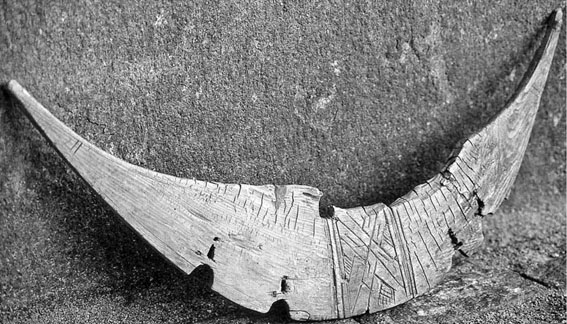
Apart from this divergent cultural impulses but with variable intensity characterize both parts. The South Sami area seems to be more old-fashioned in vocabulary and boat technology than their northern counterpart. This appears to be a problematic idea, but it is my present point of view. The terminology relating to boats and boat handling of the coastal and river Samis in North Norway is simply impressive and also well-structured.
Besides, differences can be discerned in the transition to the boat traditions of the majority cultures (Swedes, Norwegians, Finns). These transitions apparently occurred in stages. Already in 1695 Rudbeck the Younger records iron nails in the large rapid-shooters boats on the Torne river. At the middle of the 18th century clinker-nailed boats from Norway had been introduced in earnest at the big lake Överuman in the Umeälven river system in Västerbotten further south, according to Norman. At this time the small sewn håpar were still numerous east of the lake Tärnasjön in Sorsele, in small waterways and lakes like in the lower parts downstream Umeälven.
Within the water system of Ångermanälven the sewn boats appear in this period still to reign supreme amongst the Forest Sami. Probably the same conditions would be valid for the Forest Saamis in present Norrbotten and Northern Västerbotten. This conclusion is based upon the comparative wealth of later finds. If preserved (partly) and even visible in the following century they would reasonably belong to this period but not to any earlier (there are certainly exceptions). Along the great mountain lakes of Norrbotten the transition to iron nails and to Norwegian influences in boat culture would have been earlier. These contacts prevailed into our time. Quite a number of the famous nordlandsbåt were driven on toboggan-type runners across the mountains with reindeers as traction.
The differences within the vast Sami area should not be overestimated. There are obvious signs of kinship. Some similarities in boatbuilding from the Kola peninsula to the South Sami rim are striking, at least during the beginnings of last century. However, little of this has been reliably documented. Decisive for fresh research would above all be to connect the lines all-over, and to unfold the eastern perspective.
Cultural interaction and transmission.
Formerly was pointed out a one-sided influence from the Norse (the Nordic side) on the Sami in boat-building. In the light of this short survey it seems more reasonable to surmise that cultural transmission has been more mutual between the Sami and the majority cultures with their origins in the south. They were interdependent in this area. The adaption of the colonizers to the conditions in lappmarken included originally Sami boat types and boat details. Thus, among the later counterparts of the larger Sami håpar are the boats used in timber-floating in several Norrland rivers. This boats have, like the South Sami vints been used in shooting rapids. Their specialized function have made them somewhat different, larger as mentioned, and fairly low in the centre. The same boat type has with variable details been strikingly common in the lakes inland. These boats are related closely to the Sami boats described by Kristoffer Sjulsson from a period in the first half of the 19th century. The type of the timber floater's boats in the south may consequently be described as a functional survival or rather as an adapted such.
It is probable that inland Samis, of the forest variety most likely, already during the Middle Ages built boats for the farmers in the Swedish-speaking coastal zone. The sewn boat used by the rower of Linnæus at the Ume älv is a Saami type, but the rower was a “farmer,” (bonde) according to Linnæus. Sewn boats were used by the farmers of the northernmost settlement, Granön, at this river in the 17th century. It remains a possibility that farmers in northwestern Ångermanland still did the same in the beginning of the 19th century. It should be remembered that quite a number of the agrarian colonizers of lappmarken were themselves of Sami origin, the numbers increasing from south to north up to a third of all settlements in Jokkmokk, Norrbottens län. We know also that the coastal Samis of North Norway built boats in a much larger scale for the Norse at the Atlantic.
It appears that the Samis retained their sewing technique even in larger boats up to about the turn of the century 1700. Their products to order from Norwegian coastal farmers and fishermen must reasonably quite early have included iron-nailed vessels as well. Is it possible that certain works have been made according to the wishes of the customer in a tradition unfamiliar or at least foreign, as Gjessing assumes? This is an interesting question in a general perspective. No definite answer can be given by way of the preserved material. But it is easy to assume that any effort to follow in the steps of another tradition will mean an amalgamation of traits, such as in the Btir(d)set find (above).
We have pointed out that the Sami inland boats have got descendants in “Swedish” working boats. It is always fruitful to compare both sides of Fennoscandia. Apart from general contacts, the Samis have always been border-crossers. There has even been posed a serious question whether the classical Norwegian fishing boat type nordlandsbåten, originally was a creation of Sami boatbuilders. At least it is obvious that some of them built it in later times. Could it be a parallel to how the timber-floater's in Sweden has become what it is? However, as far as I know, there are few details in nordlandsbåtar to suggest any influence from known Sami-built boats. It need not be necessary for this discussion to ascertain that there actually are such traits. But it would be interesting to look at ancient finds, if there are any. There were districts, such as Salten (fjord) where a considerable number of Samis were boatbuilders. They were surprisingly often smiths as well, which is necessary for making iron nails!
The intimacy of the coastal (sea) Samis with Scandinavian boatbuilding may have been part of an explanation for the many loanwords in their language. Thus Gutorm Gjessing expresses this argument, “that they must have adapted their boatbuilding to the wishes and demands of their Norwegian customers.” A whole world is contained within this half-sentence. The contacts and influences were presumedly exceptionally lively in the maritime field c. AD 300-600. In this period the Norse went over entirely to iron-clenched boats. But boats could still be repaired in sewing technique in Scandinavia.
If anything similar has occurred in the later Finnish area is very uncertain, but still possible. The large northerly river boats are interesting as a point of possible convergence. Unfortunately there are no finds of early boats of this kind. The linguistic material across the whole area of the north, of course including Russia, show traces of intermittently dynamic cultural meetings and encounters. Signs of interaction and exchange in boatbuilding may be suspected in the contacts of the Saami with Russia and maybe especially Carelia.
The vast Finnish inland area was undoubtedly once settled- sparsely but anyway- by Sami-speakers. Finnish and Sami are closely related. It seems natural to try to apply a dynamic, variable and situational, concept of ethnicity. A terminological difference between suomi and same, between finne and lapp, can have been imposed from above. The (Swedish) authorities may have applied this difference in order to manage the varied tax forms between the swidden culture farmers in the coastal zone and the hunters and fishermen of the interior. It is a remarkable situation. Why was this distinction accepted by the affected groups? How to distinguish between Sami and non-Sami in this field? How to distinguish between Sami boats and non-Sami boats? Is culture or identity just a question of economy in a certain sense?
At least the complex of linguistic aspects of boats as well as other cultural phenomena should be pursued with a cross-disciplinary aim. I would recommend the kind of study that Olavi Korhonen has carried out. It will in the present paradigm largely be a question of a holistic picture, social structure, ideology, symbols, materials, techniques and finished products. On the way local, cultural and possibly ethnic traditions in boat building will be covered. But to pursue only boat building is probably a dead end.
Anyway, this text gives a range of ideas for future field surveys and studies also in this field. Some examples are neglected areas such as the large Sami-connected river and sea boats, those enigmatic sewn cargo boats that Olaus Magnus mentions from the Bothnian region, and coastal Sami boats from later times.
It is necessary to fill the comparative dearth of materials for the period 1850-1950, where what is imagined as Sami and non-Sami is irrelevant. However it is as important to bind together the entire Sami area from east to west. This complex is still a fragmentarily known chapter. The same goes particularly for Northwest Russia. I believe it can still be done.
